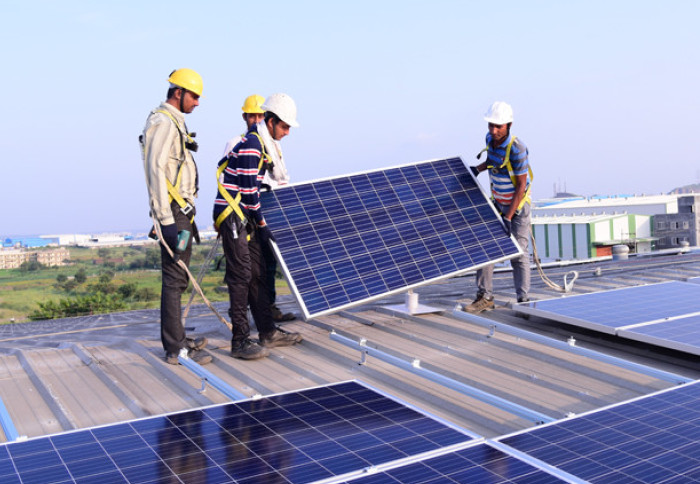Study finds huge global potential for energy from rooftop solar panels
by Simon Levey

Solar panel being installed on a rooftop. Credit: World Bank
A first-of-its-kind study into rooftop solar energy identifies 'hot-spots' where investment could have the greatest benefits for climate change.
The first detailed global assessment of the electricity generation potential of rooftop solar panels has revealed that the total global potential for electricity produced in this way exceeds all the energy used worldwide in 2018.
This new data set will help governments or organisations, business owners to identify solar power 'hot-spots' where they can mobilise investment for new solar panels, and this would help in accelerating the adoption of solar power Dr Shivika Mittal Study co-author
Scientists from University College Cork (UCC) in Ireland, Columbia University in the Unites States, Ahmedabad University in India and Imperial College London in the United Kingdom have published their findings in the journal Nature Communications.
The new data has also identified 'hot-spots' in India and China where investment in rooftop solar panels could have the greatest impact on climate change and the environment.
Dr Shivika Mittal, Research Associate in Energy and Integrated Assessment Model at the Grantham Institute - Climate Change and the Environment at Imperial College London, and a co-author of the study, said: "The cost of generating electricity from solar rooftop panels has declined significantly in the last decade.
"This new data set will help governments or organisations, business owners to identify solar power 'hot-spots' where they can mobilise investment for new solar panels, and this would help in accelerating the adoption of solar power," she continued.
Renewable energy is essential to stopping climate change
Solar photovoltaics (PV) technology, which are the most cost-effective type of solar panels, are often mounted on the rooves of homes, and commercial or industrial buildings, and are key to generating electricity without worsening the climate crisis.

Solar powered electricity is considered to be one of the most promising technologies to help slow and halt the progress of climate change because they generate 'renewable' electricity from sunlight. This electricity for homes and businesses is therefore produced without burning the fossil fuels that release greenhouse gases into the atmosphere including carbon dioxide and methane.
Solar PV panels are currently a great choice to produce renewable energy thanks to recent improvements the technology, fast-reducing costs and how easy they are to install - taking 2 days for a typical domestic property - and the International Renewable Energy Agency (IRENA) expects they could supply 25–49% of global electricity needs by 2050.
Despite such expert predictions, nobody had assessed the global potential for solar PV to generate electricity, the geographic distribution of the best areas to install it, and the costs of meeting this challenge.
Rooftops are the ideal location for solar panels
Now, the research team behind this research paper have mapped 130 million square kilometres of global land surface area to identify 0.2 million square kilometres of rooftop area using a new computer programme called a Machine Learning algorithm to identify how much of the Earth's surface is a rooftop suitable for solar panels.

This rooftop area was then analysed to calculate the total global potential for rooftop solar PV to generate electricity - and identified the countries with some of the best and worst potential.
The authors found a global potential of 27 petawatt-hour per year, which exceeded global energy consumption in 2018, although realising this future potential would depend on the development and cost of solutions to store the generated energy if it couldn't be used immediately when the sun is shining.
Co-author Professor Brian Ó Gallachóir from UCC said: "This potential of 27 PWh per annum from rooftop solar is very significant. For comparison, our total electricity use in all homes around the world was 6 PWh in 2019. These results are very timely in the context of the global climate change conference in the UK next month. Rooftop solar PV not only helps to reduce emissions but also to involve homeowners directly in the energy transition."
Access to electricity is an important global need
The researchers found the areas with the greatest potential for electricity generated by rooftop solar panels in Asia, North America and Europe.
Some of the areas with the lowest costs for attaining the maximum potential are in India, where it would cost $66 per megawatt-hour, and China, where it would $68 per megawatt-hour to reach this potential.
The authors conclude that their findings will have important implications for sustainable development and climate change mitigations efforts. Globally, nearly 800 million people were without proper access to electricity in 2018, the majority of who are living in rural areas.
The United Kingdom and United States are among the most costly countries, costing $251 and $238 per megawatt-hour.
"For the first time, we can analyse the spatial and temporal characteristics of global rooftop photovoltaics with improved accuracy using a combination of big data, machine learning and GIS. This study can aid in improved representation of rooftop solar photovoltaics in global energy systems," said Siddharth Joshi, researcher at MaREI, the SFI Research Centre for Energy, Climate and Marine in University College Cork (UCC), the lead author of the study.
Reference:
"High resolution global spatiotemporal assessment of rooftop solar photovoltaics potential for renewable electricity generation" is published in Nature Communications by Siddharth Joshi, Shivika Mittal, Paul Holloway, Priyadarshi Ramprasad Shukla, Brian Ó Gallachóir and James Glynn.
This news story was based on a press release prepared by UCC.
Article text (excluding photos or graphics) © Imperial College London.
Photos and graphics subject to third party copyright used with permission or © Imperial College London.
Reporter
Simon Levey
Communications Division